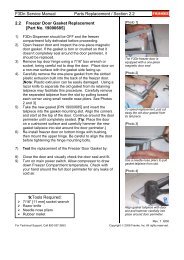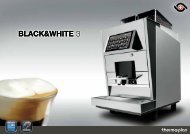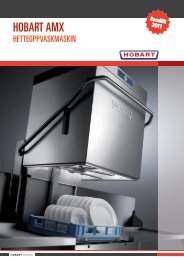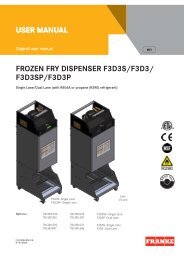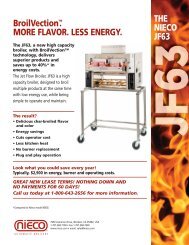F3Dn Service Manual Refrigeration / Section 4.1 4.1 ... - FFSNorge
F3Dn Service Manual Refrigeration / Section 4.1 4.1 ... - FFSNorge
F3Dn Service Manual Refrigeration / Section 4.1 4.1 ... - FFSNorge
You also want an ePaper? Increase the reach of your titles
YUMPU automatically turns print PDFs into web optimized ePapers that Google loves.
<strong>F3Dn</strong> <strong>Service</strong> <strong>Manual</strong> <strong>Refrigeration</strong> / <strong>Section</strong> <strong>4.1</strong><br />
<strong>4.1</strong> Basic [Operator] <strong>Refrigeration</strong> Maintenance<br />
[Photo 1]<br />
[Before attempting service failure diagnosis or component<br />
repairs, verify basic operator maintenance has been done.]<br />
PROBLEM: Freezer is running but will not reach 0° F [-18° C]<br />
or lower. High temperatures caused by a dirty condenser coil<br />
or extreme ice buildup may cause the freezer to function<br />
improperly, not maintain temperature or cease operating.<br />
1) Open the freezer compartment door and verify that it has<br />
been defrosted. If significant ice buildup is present, turn<br />
OFF main power, open the freezer compartment door<br />
and allow the ice to melt.<br />
2) Check freezer door gasket for damage. If damage is<br />
found, see <strong>Section</strong> 2.2 Door Gasket Replacement.<br />
3) Remove the top-right side louvered access panel. [Lift up<br />
and pull out.]<br />
4) Inspect the Condenser Coil Filter. If dirty, wash in sink.<br />
Allow the filter to dry completely before replacing.<br />
5) Inspect the condenser coil to ensure it is clean and free<br />
of dust and debris. If it is dirty, clean it with a soft bristle<br />
brush or portable vacuum.<br />
CAUTION<br />
Avoid contact with fins on the condenser coil and any<br />
refrigeration lines. The fins are very sharp and can cause<br />
cuts. Certain refrigerant lines can be very hot and could cause<br />
burns to exposed skin. The use of gloves is recommended.<br />
To inspect condenser coil and<br />
coil filter, remove louvered<br />
access panel on right side near<br />
unit top.<br />
[Photo 2]<br />
Inspect the condenser coil filter.<br />
If dirty, wash in the sink and<br />
allow to dry before replacing.<br />
6) Test unit for operation within 0° to -10° F or -18 to -23° C<br />
normal operating temperature range.<br />
7) If these steps correct problem, notify unit manager of<br />
problems noted with crew cleaning or operator<br />
preventative maintenance. If problem persists, see<br />
Troubleshooting Guide and <strong>Section</strong>s 3.8 and 4.2 - 4.9.<br />
PROBLEM: The Freezer will not run when turned ON.<br />
1) Verify unit is plugged in to correct voltage power supply.<br />
2) Check circuit breaker for that outlet or use a test meter to<br />
verify power at outlet.<br />
3) If these simple steps return unit to service, notify unit<br />
manager of fix.<br />
4) If unit is plugged in, turned on and power is present at the<br />
outlet but <strong>Refrigeration</strong> System will not power-up, see<br />
Troubleshooting Guide and <strong>Section</strong>s 4.4 through 4.9.<br />
‣<br />
Rev. 2 11/06<br />
For Technical Support, Call 800-537-2653.<br />
Copyright Ó 2006 Franke, Inc. All rights reserved.
<strong>F3Dn</strong> <strong>Service</strong> <strong>Manual</strong> <strong>Refrigeration</strong> / <strong>Section</strong> 4.2<br />
4.2 Freezer Thermostat Controller Replacement<br />
[120V/60Hz use Part No. 19000652]<br />
[230V/50Hz use Part No. 19000853]<br />
1) <strong>F3Dn</strong> Dispenser should be OFF and the freezer<br />
compartment fully defrosted before proceeding.<br />
2) Disconnect power at outlet. [Pull plug.]<br />
3) Using a medium Phillips screwdriver, remove two screws<br />
from top of front control panel and four screws securing<br />
the sloped access panel.<br />
4) The Danfoss Controller is mounted to the side of an<br />
electric chase, has a knob graduated 1-9; three<br />
connected wires and two cable assemblies. Remove the<br />
press fit knob from the controller.<br />
5) Using a small pliers or adjustable wrench, remove the<br />
hex nut holding controller to the side of metal chase.<br />
6) Disconnect the two cable assemblies from the controller.<br />
Label then disconnect the three wires from the controller<br />
terminals.<br />
7) Place new controller near chase and reconnect the three<br />
wires to the ¼” [6 mm] spade terminals, per your labels.<br />
8) Reconnect cable assemblies from: the LED Display and<br />
the remote sensor. [Connectors are different and can<br />
only be assembled one way.]<br />
9) Position new controller inside electric chase and tighten<br />
hex nut securely…but DO NOT over-tighten.<br />
10) Using the screws previously removed, re-install electric<br />
chase cover.<br />
11) Replace press fit controller knob.<br />
12) Verify the new thermostat is set between 4-5.<br />
Test Operation of new thermostat controller by:<br />
13) Plug in unit to power source.<br />
14) Turn ON unit at Main Power-ON Switch.<br />
15) Allow compressor to draw unit down to its normal<br />
operating temperature range, which should be between 0<br />
and -10° F [-18 to -23° C]. [Cool down time of 1-1/2 to 2<br />
hours is normal.]<br />
16) Close [black] sloped service access and front control<br />
panels and return dispenser to normal operating location.<br />
[Photo 1]<br />
Remove two screws from front<br />
control panel & four screws that<br />
secure sloped access panel.<br />
[Photo 2]<br />
Remove press fit knob, hex<br />
mounting nut, two cable<br />
harnesses & three wire<br />
connectors to pull thermostat.<br />
[Photo 3]<br />
Unit ships from factory with<br />
thermostat preset at 5. [Dial<br />
range is from 1 to 9.]<br />
‣<br />
Rev. 2 11/06<br />
For Technical Support, Call 800-537-2653.<br />
Copyright Ó 2006 Franke, Inc. All rights reserved.
<strong>F3Dn</strong> <strong>Service</strong> <strong>Manual</strong> <strong>Refrigeration</strong> / <strong>Section</strong> 4.3<br />
4.3 Condenser Fan Motor Replacement<br />
[115V/60Hz use P/N: M40045-CA27-E8]<br />
[230V/50Hz use P/N: M4Q045-CF13-A7]<br />
1) Roll <strong>F3Dn</strong> unit out and disconnect power at outlet. [Pull<br />
plug.]<br />
2) If needed, position a stepladder or stable work platform<br />
to access the compressor/condenser compartment.<br />
3) Using a medium Phillips screwdriver, remove two screws<br />
securing the front control panel and the four screws on<br />
the sloped, matt black access panel.<br />
4) Lift off and remove metal cover over the black metal<br />
relay/capacitor box mounted behind the compressor.<br />
5) Disconnect the three Condenser Fan Motor wires from<br />
the terminal block using needle nose pliers. [Wire colors<br />
are Blue/Brown/Green.]<br />
6) Using a 3/8” [10 mm] wrench or socket, remove the four<br />
lock nuts securing motor/fan assembly to condenser<br />
mounting frame.<br />
7) Using a 1/8” [3 mm] Allen wrench, loosen setscrew<br />
securing fan blade to motor shaft.<br />
8) Using the 3/8” [10 mm] wrench or socket, remove the<br />
four lock nuts securing motor to fan guard.<br />
9) Attach the new Condenser Fan Motor P/N: M40045-<br />
CA27-E8 [115V/60Hz] or M4Q045-CF13-A7 [230V/50Hz]<br />
to fan guard using the four nuts just removed.<br />
10) Position fan on motor shaft with setscrew facing flat side<br />
of shaft then tighten setscrew.<br />
11) Position fan assembly over four mounting screws and<br />
secure using the four lock nuts removed earlier.<br />
12) Reattach the three Fan Motor wires at terminal block.<br />
[Wire colors are Blue/Brown/Green.]<br />
13) Slide metal cover back on relay/capacitor box.<br />
Test Operation of new Condenser Fan Motor by:<br />
14) Plug in unit power cord to power supply.<br />
15) Turn ON unit at Main Power-ON Switch.<br />
16) Allow compressor to draw unit down to its normal<br />
operating temperature range, which should be between 0<br />
and -10° F [-18 to -23° C]. Unit should maintain that<br />
operating temperature if freezer compartment door<br />
remains closed.<br />
17) Reattach the sloped compressor access panel and<br />
control panel; and return dispenser to normal operating<br />
location.<br />
[Photo 1]<br />
Remove the front control panel<br />
and sloped access panel. The<br />
relay/capacitor box is mounted<br />
above the compressor.<br />
[Photo 2]<br />
Disconnect Condenser Fan<br />
Motor wires inside the metal<br />
relay/capacitor box.<br />
[Photo 3]<br />
Remove the four fan housing<br />
mounting nuts, remove fan blade<br />
and separate motor from fan<br />
cover by removing four nuts.<br />
‣<br />
Rev. 2 12/06<br />
For Technical Support, Call 800-537-2653.<br />
Copyright Ó 2006 Franke, Inc. All rights reserved.
<strong>F3Dn</strong> <strong>Service</strong> <strong>Manual</strong> <strong>Refrigeration</strong> / <strong>Section</strong> 4.4<br />
4.4 Start Capacitor/Start Relay Replacement:<br />
[Photo 1]<br />
For Model: Use Capacitor P/N: Use Relay P/N:<br />
115/V 60Hz 19001085 19001082<br />
230V/50Hz 19001080 [Kit containing both]<br />
1) Roll <strong>F3Dn</strong> unit out to disconnect power at outlet.<br />
2) Using a medium Phillips screwdriver, remove two screws<br />
securing control panel and the four screws on the<br />
sloped, matt black access panel.<br />
3) Lift off and remove metal cover over black metal<br />
relay/capacity box mounted behind the compressor.<br />
4) Using needle nose pliers, carefully remove the capacitor<br />
leads from the terminal block, without touching each<br />
other or the metal box.<br />
WARNING<br />
High voltage warning. Use caution. There is a danger of<br />
electrical shock, which can cause injury or even death!<br />
5) Unsnap the plastic retainer clip holding the capacitor,<br />
and then remove the capacitor.<br />
6) Install the new capacitor and snap retainer clip.<br />
7) Connect capacitor leads to the terminal block.<br />
Remove two control panel<br />
screws and four screws on the<br />
sloped panel to access<br />
compressor compartment.<br />
[Photo 2]<br />
Pull metal cover off electric<br />
component box to access<br />
capacitor and relay.<br />
[Photo 3]<br />
Test operation of Compressor by:<br />
8) Plug in unit power cord to power supply.<br />
9) Turn ON unit at Main Power-ON Switch.<br />
10) If compressor starts and runs, proceed to Step 19.<br />
11) To replace Start Relay: Using needle nose pliers,<br />
disconnect the 7 wires from the relay terminals.<br />
12) Using a small screwdriver remove 2 screws mounting the<br />
relay to the electrical enclosure and remove the relay.<br />
13) Install the new relay and secure with those two screws.<br />
14) Reconnect the 7 wires to the relay terminals, as follows:<br />
T1 = Black from capacitor; T2 = Red from compressor;<br />
T4 = Black from capacitor, White from power cord and<br />
White from compressor; T5 = Black from power cord and<br />
Black from compressor.<br />
15) Replace metal electrical box cover.<br />
Try replacing the capacitor first.<br />
If replacement of the capacitor<br />
does not start the compressor,<br />
replace the start relay.<br />
‣<br />
Test operation of Compressor by:<br />
16) Plug in unit to a 120-volt power source.<br />
17) Turn ON unit at Main Power-ON Switch.<br />
18) If compressor starts and runs, proceed to Step 19.<br />
19) Reattach sloped compressor access panel and control<br />
panel; and return <strong>F3Dn</strong> to normal operating position.<br />
For Technical Support, Call 800-537-2653.<br />
Rev. 2 12/06<br />
Copyright Ó 2005 Franke, Inc. All rights reserved.
<strong>F3Dn</strong> <strong>Service</strong> <strong>Manual</strong> <strong>Refrigeration</strong> / <strong>Section</strong> 4.5<br />
4.5 Check System [Refrigerant] Pressure<br />
and Electronic Leak Detection<br />
1) Roll <strong>F3Dn</strong> unit out to disconnect power at outlet. [Pull<br />
plug.]<br />
2) Using a medium Phillips screwdriver, remove two screws<br />
securing control panel and the four screws on the sloped<br />
access panel. [Older units]: Remove wire-form top grate.<br />
3) Using a standard manifold refrigeration gauge, confirm<br />
the following pressures for units with 16 oz. [454 gm]<br />
R404A charge:<br />
‣ Discharge Valve: 230 +/- 10 psig [16 ± 1 Bar] @<br />
80"F/27°C ambient<br />
‣ Suction Valve: 5 +/- 2 psig [.4 ± .1 Bar] @<br />
80"F/27°C ambient<br />
4) If Discharge Valve pressure is HIGH and Suction Valve<br />
pressure is LOW, check for a kinked or restricted line.<br />
5) If a kinked or restricted line is found, see <strong>Section</strong> 4.7 for<br />
Expansion Valve/Filter replacement.<br />
6) If Discharge Valve Pressure is LOW and Suction<br />
Pressure is LOW, verify leak and location with an<br />
Electronic Leak Detector. [If existing system pressures<br />
are high enough, a thorough scan with a standard leak<br />
detector may be sufficient to locate the exact location.]<br />
7) If system pressure is too low or leak[s] is intermittent and<br />
difficult to detect, pressurize the system with Nitrogen to<br />
an equalized MAXIMUM of 150 PSIG [10.5 Bar].<br />
8) Use electronic leak detector or application of a soap<br />
solution to locate any and all leaks.<br />
9) IMPORTANT: Make sure the condensing unit is off when<br />
checking for leaks. Air movement from the fan would<br />
inhibit the ability of the leak detector to sense refrigerant.<br />
NOTE: Do not use an electronic leak detector to locate<br />
leaks inside the freezer evaporator housing. The foam<br />
insulation used inside the evaporator housing contains<br />
HFCs, which will generate false readings. Call Franke<br />
<strong>Service</strong> if you suspect a leak in this area.<br />
10) If a leak is found, see <strong>Section</strong> 4.6 for Leak Repair<br />
Procedures.<br />
[Photo 1]<br />
Remover two control panel<br />
screws and four screws on the<br />
sloped panel, to access<br />
compressor compartment.<br />
[Photo 2]<br />
Check Discharge and Suction<br />
Valve pressures using a<br />
manifold refrigeration gauge.<br />
[Photo 3]<br />
If system pressure is too low or<br />
the leaks difficult to pinpoint,<br />
pressurize system with 150<br />
PSIG [10.5 Bar] of Nitrogen and<br />
use an electronic leak detector<br />
or soap solution.<br />
‣<br />
Rev. 2 12/06<br />
For Technical Support, Call 800-537-2653.<br />
Copyright Ó 2005 Franke, Inc. All rights reserved.
<strong>F3Dn</strong> <strong>Service</strong> <strong>Manual</strong> <strong>Refrigeration</strong> / <strong>Section</strong> 4.6<br />
4.6 Repair System [Refrigerant] Leak<br />
1) Roll <strong>F3Dn</strong> unit out to disconnect power at outlet. [Pull<br />
plug.]<br />
2) Using a medium Phillips screwdriver, remove two screws<br />
securing control panel and the four screws on the sloped<br />
access panel.<br />
3) Repair or replace refrigerant lines as needed.<br />
4) Note: Recover any residual refrigerant and ensure line<br />
pressure is equalized to zero, before opening the<br />
refrigeration system.<br />
IMPORTANT: Any residual refrigerant charge<br />
should be recovered in strict accordance with the<br />
Federal Clean Air Act.<br />
5) Note: For larger leaks that may have contaminated the<br />
system, replace the expansion valve and filter. [See<br />
<strong>Section</strong> 4.7] In addition, the system may need to be<br />
drained completely and new Polyol Ester Oil added. If<br />
required, the old Polyol Ester Oil should be recovered<br />
and disposed of in accordance with Federal Laws<br />
covering the handling of hazardous materials.<br />
6) When resealing the system, use a continuous Nitrogen<br />
charge to assure no contaminants enter the system,<br />
especially when brazing.<br />
7) Before recharging the system, pull a vacuum equivalent<br />
to 30 inches [760 mm] of Mercury, for a minimum of 30<br />
minutes.<br />
8) Recharge the system with R404A refrigerant, per<br />
nameplate label specification.<br />
Test operation of <strong>Refrigeration</strong> System by:<br />
9) Plug in unit power cord to power source.<br />
10) Turn ON unit at Main Power-ON Switch.<br />
11) If compressor starts and brings the Freezer compartment<br />
down to the normal operating temperature range of 0 to -<br />
10° F [-18 to -23° C], proceed to Step 12.<br />
12) Reassemble sloped access panel and control panel and<br />
return <strong>F3Dn</strong> dispenser to normal operating location, if it<br />
was moved.<br />
[Photo 1]<br />
Remove two control panel<br />
screws and four screws on the<br />
sloped panel to access<br />
compressor compartment.<br />
[Photo 2]<br />
Recover any residual refrigerant<br />
and ensure line pressure is zero<br />
before opening system.<br />
[Photo 3]<br />
When resealing the system or<br />
repairing leaks, use continuous<br />
Nitrogen charge to keep<br />
contaminants out.<br />
‣<br />
Rev. 2 11/06<br />
For Technical Support, Call 800-537-2653.<br />
Copyright Ó 2006 Franke, Inc. All rights reserved.
<strong>F3Dn</strong> <strong>Service</strong> <strong>Manual</strong> <strong>Refrigeration</strong> / <strong>Section</strong> 4.7<br />
4.7 Thermostatic Expansion Valve & Filter<br />
Assembly Replacement<br />
[Part Number: 19000496 (Expansion Valve)]<br />
1) Roll <strong>F3Dn</strong> unit out to disconnect power at outlet. [Pull<br />
plug.]<br />
2) Using a medium Phillips screwdriver, remove two screws<br />
securing control panel and the four screws on the sloped<br />
access panel.<br />
3) Note: Recover any residual refrigerant and ensure line<br />
pressure is equalized to zero, before opening the<br />
refrigeration system.<br />
IMPORTANT: Any residual refrigerant charge should<br />
be recovered in strict accordance with the Federal<br />
Clean Air Act.<br />
4) Cut line to free valve and filter using a small tubing<br />
cutter. Remove existing Expansion Valve & Filter<br />
Assembly.<br />
5) Install new Expansion Valve & Filter Assembly [P/N:<br />
19000496]. IMPORTANT: wrap valve body with a wet<br />
rag before applying any heat, to prevent any damage.<br />
Braze lines as required.<br />
6) When resealing the system, use a continuous Nitrogen<br />
charge to assure no contaminants enter the system,<br />
especially when brazing.<br />
7) Mount sensor bulb using the strap clamp provided to the<br />
suction line, in the “10 o’clock” or “2 o’clock” position.<br />
DO NOT mount in 12 o’clock or 3 to 9 o’clock position.<br />
8) Before recharging the system, pull a vacuum equivalent<br />
to 30 inches [760 mm] of Mercury, for a minimum of 30<br />
minutes.<br />
9) Recharge the system with R404A refrigerant per<br />
nameplate label specification.<br />
Test operation of <strong>Refrigeration</strong> System by:<br />
10) Plug in power cord to power outlet.<br />
11) Turn ON unit at Main Power-ON Switch.<br />
12) If compressor starts and brings the Freezer compartment<br />
down to the normal operating temperature range of 0 to -<br />
10° F [-18 to -23° C], proceed to Step 13.<br />
13) Replace black foam insulation enclosing the expansion<br />
valve and sensor to minimize condensation. Secure<br />
insulation with electrician’s tape.<br />
[Photo 1]<br />
Remover control panel screws<br />
and four screws on the sloped<br />
panel to access compressor<br />
compartment.<br />
[Photo 2]<br />
Recover any residual refrigerant<br />
and ensure line pressure is zero<br />
before opening system.<br />
[Photo 3]<br />
When resealing the system, use<br />
a continuous Nitrogen charge to<br />
keep contaminants out.<br />
‣<br />
14) Replace sloped access panel and control panel; and<br />
return <strong>F3Dn</strong> dispenser to normal operating location.<br />
For Technical Support, Call 800-537-2653.<br />
Rev. 2 12/06<br />
Copyright Ó 2006 Franke, Inc. All rights reserved.
<strong>F3Dn</strong> <strong>Service</strong> <strong>Manual</strong> <strong>Refrigeration</strong> / <strong>Section</strong> 4.8<br />
4.8 Condensing Unit Replacement<br />
[110V/60Hz use P/N: 19000359]<br />
[230V/50Hz use P/N: 19000453]<br />
1) Roll <strong>F3Dn</strong> unit out to disconnect power at outlet.<br />
2) Using a medium Phillips screwdriver, remove two screws<br />
securing control panel and the four screws on the sloped<br />
access panel.<br />
3) Using a 7/16” [11 mm] box wrench or socket, remove the<br />
two Condenser Assembly base mounting bolts.<br />
4) Unplug the compressor power cord at the Main Electric<br />
Supply junction box inside electrical chase.<br />
5) Note: Recover any residual refrigerant and ensure line<br />
pressure is equalized to zero, before opening the<br />
refrigeration system.<br />
IMPORTANT: Any residual refrigerant charge<br />
should be recovered in strict accordance with the<br />
Federal Clean Air Act.<br />
6) Cut the refrigerant lines.<br />
7) Lift old Compressor out of refrigeration compartment.<br />
Place new compressor in position and secure with nuts.<br />
CAUTION<br />
Compressor weights 50-pounds. Obtain help if<br />
needed to remove from refrigeration compartment.<br />
8) Clean and prepare the refrigeration line fittings, then<br />
braise all the line connections.<br />
9) Note: When resealing the system, use a continuous<br />
Nitrogen charge to assure no contaminants enter the<br />
system, especially when brazing.<br />
10) Before recharging system, pull vacuum equivalent to 30<br />
inches [760 mm] of Mercury, for minimum of 30 minutes.<br />
11) Recharge the system with R404A refrigerant, per<br />
nameplate label specifications.<br />
12) Plug in condenser power cord at power junction box.<br />
Test operation of <strong>Refrigeration</strong> System by:<br />
13) Plug in power cord to power outlet.<br />
14) Turn ON unit at Main Power-ON Switch.<br />
15) If compressor starts and brings the Freezer compartment<br />
down to the normal operating temperature range of 0 to -<br />
10° F [-18 to -23° C], repair is complete.<br />
[Photo 1]<br />
Remove the two Condenser<br />
Assembly base mounting bolts.<br />
[Photo 2]<br />
Recover any residual refrigerant<br />
and ensure line pressure is zero<br />
before opening system.<br />
[Photo 3]<br />
When resealing the system, use<br />
a continuous Nitrogen charge to<br />
keep contaminants out.<br />
@Tools/Supplies Required:<br />
‣ Medium Phillips screwdriver<br />
‣ 7/16” [11 mm] socket/wrench<br />
‣ Refrigerant Recovery Tank &<br />
fittings<br />
‣ Nitrogen Charge Tank<br />
‣ R404A Refrigerant<br />
‣ Tubing Cutter<br />
‣ Brazing Torch, etc.<br />
16) Replace sloped access panel and control panel; then<br />
return <strong>F3Dn</strong> to normal operating location.<br />
For Technical Support, Call 800-537-2653.<br />
Rev. 2 12/06<br />
Copyright Ó 2006 Franke, Inc. All rights reserved.



